Dark horse wins fighting event
The 26th edition of the famed Linares Tournament took place at the Teatro Cervantes from February 19th to March 7th in the Andalusian city that gave it its name. This would turn out to be the penultimate edition, as the event stopped being organized in 2010 for financial reasons. From 2006 through 2008, the first half of the tournament had taken place in Morelia, Mexico, while it was rumoured that in 2010 a similar arrangement would be made with the United Arab Emirates — the deal was not closed and the last edition took place solely in Linares.
The initial line-up included world number one Veselin Topalov, but the Bulgarian could not participate as a late change of dates meant his Candidates final match against Gata Kamsky would take place at the same time — Topalov beat Kamsky to become Vishy Anand's challenger for the world crown. The organizers chose Alexander Grischuk as the replacement. In a recent interview during the Candidates in Yekaterinburg, Grischuk mentioned that getting the invitation had a lot to do with a sponsorhip deal he had with Unibet Spain. Let us not forget that the Russian alternated between chess and poker at the time.
So two coincidences led to one of Grischuk's greatest achievements of his career. After all, he arrived in Linares as the seventh seed, only ahead of Leinier Dominguez in the starting list. Top seed was world number two and defending champion Vishy Anand. The Indian was followed by Vassily Ivanchuk, Magnus Carlsen and Teimour Radjabov (world numbers 3, 4 and 6 respectively). Levon Aronian and Wang Yue completed the list (11th and 13th in the world rankings).
Fighting chess was the rule that year, despite only 15 out of 56 games ended decisively. Radjabov and Ivanchuk still used the King's Indian Defence on a regular basis; sharp variations of the Semi-Slav were being explored; a young Carlsen still had the Dragon in his repertoire; Anand accepted Grischuk's poisoned pawn out of a Najdorf in round thirteen; and Aronian's creative style was in full swing throughout the event.
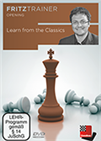 Sagar Shah shows you on this DVD how you can use typical patterns used by the Master of the past in your own games. From opening play to middlegame themes.
Sagar Shah shows you on this DVD how you can use typical patterns used by the Master of the past in your own games. From opening play to middlegame themes. 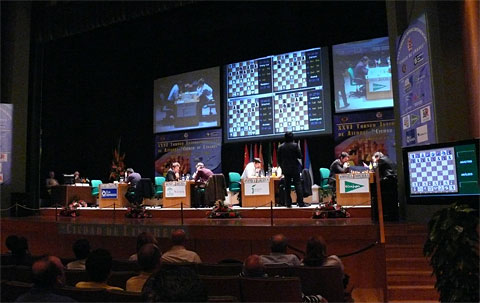
The playing hall | Photo: Frederic Friedel
Rounds 1-4: Aronian and Grischuk on +2
Defending champion Anand kicked off the tournament with two decisive results, first beating Radjabov by converting a slightly superior endgame with utmost precision, and then losing against Aronian in a sharp struggle. Curiously, four years later Anand got revenge by beating the Armenian in Wijk aan Zee after repeating eleven moves from the 2009 game. Both times, the player with the black pieces scored a memorable win.
Replay both games annotated by Dorian Rogozenco and Efstratios Grivas respectively:
The only other decisive result from rounds one to three saw Grischuk scoring a fine positional win over Wang Yue with the white pieces. Round four, on the other hand, was very eventful in terms of decisive results, as Aronian, Anand and Grischuk scored full points — Wang Yue and Dominguez were outplayed by the first two from slightly inferior endgames, while Grischuk took advantage of Radjabov's adventurous play out of a Queen's Indian Defence, showing nerves of steel to get his second win of the tournament.
Replay all games from round four with commentaries by Dorian Rogozenco:
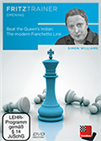 This DVD is packed full of new, exciting and novel ideas; based on a repertoire starting with the moves 1 d4 Nf6 2 c4 e6 3 Nf3 with g3! to follow.
This DVD is packed full of new, exciting and novel ideas; based on a repertoire starting with the moves 1 d4 Nf6 2 c4 e6 3 Nf3 with g3! to follow.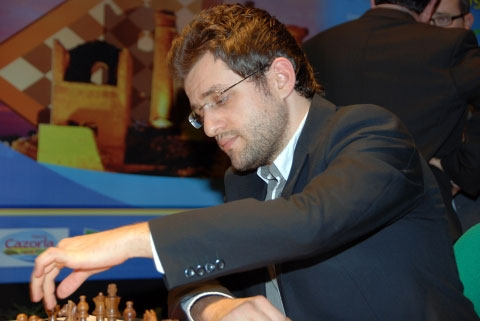
Time to beat the defending champion — Aronian during round two | Photo: Frederic Friedel
Rounds 5-8: Carlsen beats Anand for the first time
This edition of the Linares Tournament was also important insofar it saw Carlsen getting his first ever win over Anand in a classical game. The Norwegian was 18 years old but already the fourth highest-rated player in the world. Many predicted he would become the world champion someday, although perhaps few expected him to become as dominant as he has proven to be during the last decade.
The win over Anand came in round six. Out of a Semi-Slav, Carlsen launched his g-pawn to the fourth rank on move 7, following the footsteps of attacking experts Shirov and Shabalov. At the time, few people accepted to take that pawn, but Anand did. Eventually, the "Tiger of Madras" found himself defending an inferior endgame. He missed some chances to defend more stubbornly, but Carlsen showed great technique to get a fantastic victory, here annotated by GM Rogozenco:
This second phase of the tournament turned out to be relevant for the eventual final standings, as it saw Grischuk getting an important win over Aronian, also in round six. The Armenian, in fact, was the protagonist of three decisive results during this phase, following his round-six debacle with another loss, this time against Ivanchuk's King's Indian Defence, only to bounce back with a victory over Carlsen with the black pieces in round eight. The results left Grischuk in the sole lead, a full point ahead of Aronian and Ivanchuk.
Replay the games, two of which are annotated:
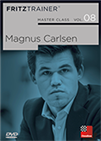 Scarcely any world champion has managed to captivate chess lovers to the extent Carlsen has. The enormously talented Norwegian hasn't been systematically trained within the structures of a major chess-playing nation such as Russia, the Ukraine or China.
Scarcely any world champion has managed to captivate chess lovers to the extent Carlsen has. The enormously talented Norwegian hasn't been systematically trained within the structures of a major chess-playing nation such as Russia, the Ukraine or China.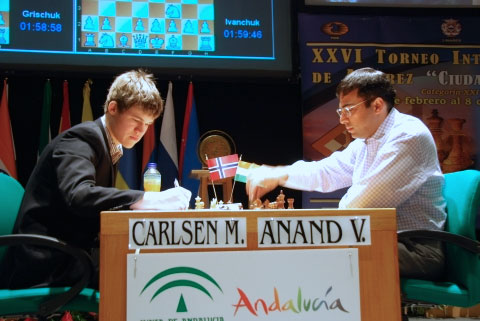
Carlsen and Anand during round six | Photo: Nadja Wittmann
Rounds 9-12: Grischuk's only loss
Four decisive games were seen during these four rounds, with three of them involving Carlsen. The Norwegian beat Dominguez from the black side of a Sicilian Dragon, lost against Wang Yue with White after using a rare line employed by Morozevich a month before in Wijk aan Zee, and scored a remarkable victory over Grischuk from the white side of a Najdorf. With two rounds left to play, the Russian's lead had shrunk to a mere half-point, with Ivanchuk and Carlsen sharing second place.
Incidentally, round ten also marks the debut of Anish Giri as an annotator for ChessBase. At age 14, he had recently become the youngest grandmaster in the world (at the time). He analysed Carlsen's loss against Wang and the Norwegian's victory over the tournament leader. Mihail Marin annotated Carlsen's win in the Dragon:
 Volume one of the DVD deals with 9.Bc4, White's sharpest option, and shows how Black can counter this ambitious try by White with the main lines of the Soltis variation (12.h5), which was played by Magnus Carlsen regularly as well.
Volume one of the DVD deals with 9.Bc4, White's sharpest option, and shows how Black can counter this ambitious try by White with the main lines of the Soltis variation (12.h5), which was played by Magnus Carlsen regularly as well.
With his trademark orange juice — Carlsen beat sole leader Grischuk | Photo: Frederic Friedel
Rounds 13-14: Ivanchuk catches Grischuk
The home stretch of the competition was all about the penultimate day of action. Ivanchuk defeated Aronian after it was not clear why the Armenian gave up a pawn in the early middlegame, while both Grischuk and Carlsen missed chances to score all-important wins, against Anand and Radjabov respectively.
Ivanchuk's win left him tied in first place, while Carlsen went into the last day of action a half point behind the co-leaders. The final round saw all games finishing peacefully, which meant Grischuk and Ivanchuk tied on first place on 8 out of 14. The prize money was split evenly — each took home 87,500 Euros — but the Russian was declared the champion on tiebreaks. The first criterion was the direct result (the co-leaders drew both their encounters), while the second criterion of most wins favoured the Russian, who had scored three full points throughout the event.
The key games from round thirteen were annotated by Anish Giri:

Fan favourite Vassily Ivanchuk | Photo: Frederic Friedel
Final standings
| # |
Name |
Rating |
Points |
Wins |
TPR |
| 1 |
Alexander Grischuk (Russia) |
2733 |
8 |
3 |
2809 |
| 2 |
Vassily Ivanchuk (Ukraine) |
2779 |
8 |
2 |
2802 |
| 3 |
Magnus Carlsen (Norway) |
2776 |
7½ |
|
2781 |
| 4 |
Viswanathan Anand (India) |
2791 |
7 |
|
2750 |
| 5 |
Teimour Radjabov (Azerbaijan) |
2761 |
6½ |
|
2726 |
| 6 |
Wang Yue (China) |
2739 |
6½ |
|
2729 |
| 7 |
Levon Aronian (Armenia) |
2750 |
6½ |
|
2727 |
| 8 |
Leinier Domínguez (Cuba) |
2717 |
6 |
|
2711 |
All games
Links




























